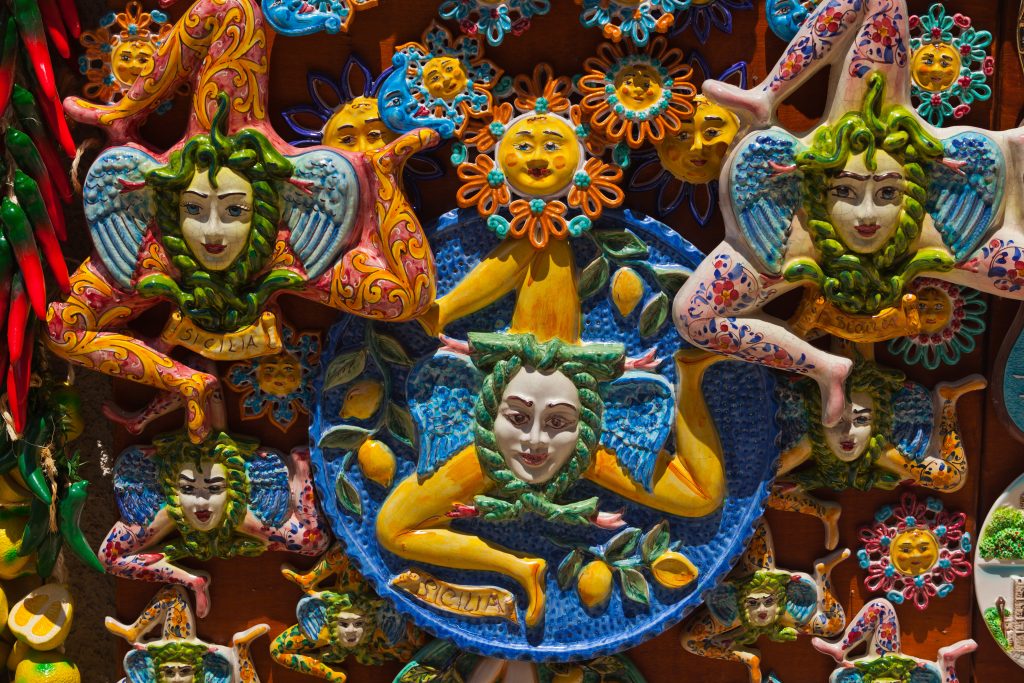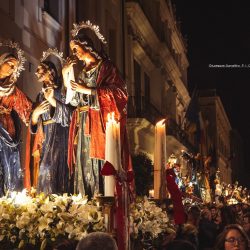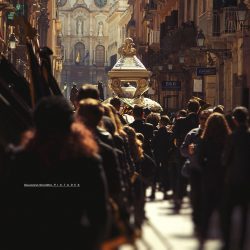History and folklore in Trapani

Narrowly situated between the sea and Mount Erice, the ancient Drepanon developed around its port. Originally it was a Sicanian village and it then became a small, fortified town where traders, fishermen and craftsmen from diverse populations lived for centuries, such as the Elyminians who populated Erice and a small group of Ionians.
It was a small seaside town founded by the Phoenicians who sailed across the Mediterranean seas and made Trapani a trading Empire. From the IX Century BC the Phoenicians lost their independence and settled in the western Mediterranean. They founded Carthage and reinforced Trapani, transforming the latter into an important port for the control of various trading goods. In this period the history of Trapani is indissolubly linked to that of Carthage. The town assisted in the great naval battles between the Carthaginians and the Romans: the battle of 249 BC that witnessed the defeat of the Roman float, and the battle of the Egadi in 241 BC which allowed the Romans to occupy Trapani. The Roman period notably penalized the town which lost its political autonomy, land ownership and endured new taxes and impositions. In 395 Sicily, and Trapani itself, were taken over by the Western Roman Emperor. These were difficult years, also because of the numerous Barbaric invasions. The town was reborn under the domination of the Arabs who began their occupation of Sicily in 827.
The Arabs called Trapani Itrabinis, Tarabanis, Trapanesch and their presence significantly marked the town: in architecture, agriculture, art, language and culture. The port was enlarged, new districts were built and small ownership was reintroduced. The Arabs also introduced new productions; they built hydraulic-engineering works; revolutionised the fishing techniques, and brought the port back to its original splendour. In 1097 Trapani was conquered by the Norman Ruggero. This was yet another period of great prosperity for the land. The port enjoyed duty free trade, and the town began hosting consulates of the most important traders from Geneva, Pisa, Venice, Florence, Amalfi and Catalonia.

The Roman Catholic religion became the official religion under the Normans. In the Suevian period, beginning from 1194, the importance of Trapani’s port was confirmed. Under the reign of Carlo d’Angio’, Trapani endured a period of difficulty due to heavy tax pressures.
The Sicilian Vespri of 1282, in which numerous notables from Trapani participated, brought the Angionian domination in Sicily to an end. This is when the Aragonese domination began. The town experienced a new urbanisation under Giacomo II of Aragon. Carlo V further developed the activities of traders and craftsmen. The Spanish domination ended in 1713. After the brief Sabaudian and Austrian dominations, from the second half of the seventh century, the Bourbonist reign began and governed Sicily until 1860. In this period the people of Trapani dedicated themselves to commerce and industry. Naval activity flourished, as well as the tuna and salt industries. While it proved to be disinterested in the 1820 insurrection, Trapani participated in the 1848 revolts. In 1899 King Umberto I bestowed the town with a gold medal for the events of 1848.
The town made an important contribution to the unification of Italy and confirmed its importance in the sectors of agriculture and food. However the geographical distance from the big markets brought an inexorable decline which was accentuated even more in the first years of the twentieth century and during the First World War. Yet the cultural and political activities remained particularly vivacious.
During the twenty years of fascism the economy of the area marginally improved. The Second World War severely affected the town with the destruction of the entire district of San Pietro, the oldest part of Trapani, and of Garibaldi Theatre which was built in 1849. The town suffered twenty-eight air raids and was thus the ninth most bombarded town in the country. On 22 July 1943 the allied troops arrived in Trapani’s Square and found a population enduring dramatic living conditions. The difficult reconstruction period between 1950 and 1965 brought the town to re-establish industrial and commercial activities.
The earthquake of the Valley of Belice in January 1968 once again provoked repercussions and damage to the town of Trapani.
(Comune di Trapani: https://comune.trapani.it/)

credits: https://www.misteriditrapani.it/
Trapani is a city rich in traditions and popular devotion.
The people of Trapani are proud of their food and wine traditions, such as couscous, celebrated during the Cous Cous Fest in September.
Or even the popular songs and dances represented by the Coro Città di Trapani, an association dedicated to these forms of artistic expression, which has been recognized for its cultural value and included in the Register of Intangible Heritage of Sicily.
However, it is the religious events that create great involvement for the Trapani community. One of these is the Feast of Sant’Alberto, which is celebrated on August 7, and is dedicated to Sant’Alberto degli Abbati, venerated as the protector of farmers and sailors. But the event that attracts numerous faithful and tourists every year is Holy Week in which rites, processions and religious functions take place which combine faith, traditions and folklore, creating a unique and evocative atmosphere. The one that has stood out since the 16th century is the Procession of the Mysteries.




credits: https://it.wikipedia.org/
The Procession of the Mysteries, attracts thousands of believers, devotees and tourists every year, who are intrigued and enticed by this fiery display of religious fervour that has been repeated, unchanged and emotional, for over 400 years.
Originally called Las Casazas and believed to have been introduced from Spain in the 16th century, it has been performed every year since then, with few discontinuities throughout history.
The 18 sculptural groups and two simulacra, mounted on special wooden ‘vare’as supports, parade through the city’s streets. The statues were made of wood, glue and cloth, between the 17th and 18th centuries, by Trapani artisans’ workshops. They represent characters and scenes from the passion and death of Christ. Initially there were only six, but over time this number grew to 18. The oldest is the Ascent to Calvary.
It is believed that the procession has its roots in the period of Spanish domination of the island and was initially organised by a confraternity. As time went by, it was then entrusted to craftsmen and guilds who still organise the event today.
There are two hypotheses regarding the meaning of the term Mysteries. According to some, it has to do with ‘ministry’, the religious office, while others believe that it is linked to the word ‘mestiere’ (meaning ‘craft’), referring to the guilds of arts and crafts with which each sacred group is associated.
According to tradition, the procession is held at 2 pm. on Holy Friday, when the Sacred Groups make their solemn exit from the Church of Purgatory. Following a precise ritual, the “caporale” with a blow of the “ciaccola”, an instrument similar to the castanet, gives orders to the “massari” and young volunteers to lift the sacred group onto their shoulders. A second blow initiates their movement.
For 24 hours, without interruption, a band plays funeral marches as the route winds its way through the main streets of the city. The most characteristic streets of the old town are trodden at night, while drums beat continuously and crowds of people silently follow the parade. At dawn, the Mysteries reach the Barracche, traditional fishing district near the city harbour and fish market. Here, they prepare for the last stretch of the route, the one that will take them back to the Purgatory Church.
On Saturday morning, Piazza Purgatorio once again bustles with people for the most exciting moment of the procession: the return of the Sacred Groups into the Baroque church that guards them all year round. They enter one by one, to the accompaniment of the band and the long applause of those attending the event. The ciaccole continue to play until the time when the door closes again. But not before a final “annacata”, that is, a rocking of the sculptural group carried on the shoulders that recalls that of the “naca”, or cradle.
This brings to an end a unique tradition, strongly linked to the territory, which, every year represents a special occasion to visit Trapani while savouring the Italian atmosphere of Easter.




